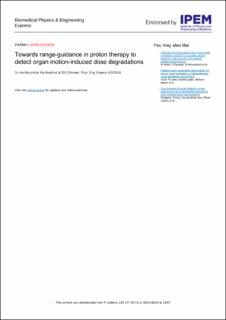| dc.contributor.author | Busch, Kia | |
| dc.contributor.author | Andersen, Andreas G. | |
| dc.contributor.author | Petersen, Jørgen B.B. | |
| dc.contributor.author | Petersen, Stine E. | |
| dc.contributor.author | Rønde, Heidi S. | |
| dc.contributor.author | Bentzen, Line | |
| dc.contributor.author | Pilskog, Sara Margareta Cecilia | |
| dc.contributor.author | Skyt, Peter | |
| dc.contributor.author | Nørrevang, Ole | |
| dc.contributor.author | Muren, Ludvig Paul | |
| dc.date.accessioned | 2023-01-06T15:08:39Z | |
| dc.date.available | 2023-01-06T15:08:39Z | |
| dc.date.created | 2022-05-23T13:25:42Z | |
| dc.date.issued | 2022 | |
| dc.identifier.issn | 2057-1976 | |
| dc.identifier.uri | https://hdl.handle.net/11250/3041663 | |
| dc.description.abstract | Introduction: Internal organ motion and deformations may cause dose degradations in proton therapy (PT) that are challenging to resolve using conventional image-guidance strategies. This study aimed to investigate the potential of range guidance using water-equivalent path length (WEPL) calculations to detect dose degradations occurring in PT.
Materials and methods: Proton ranges were estimated using WEPL calculations. Field-specific isodose surfaces in the planning CT (pCT), from robustly optimised five-field proton plans (opposing lateral and three posterior/posterior oblique beams) for locally advanced prostate cancer patients, were used as starting points. WEPLs to each point on the field-specific isodoses in the pCT were calculated. The corresponding range for each point was found in the repeat CTs (rCTs). The spatial agreement between the resulting surfaces in the rCTs (hereafter referred to as iso-WEPLs) and the isodoses re-calculated in rCTs was evaluated for different dose levels and Hausdorff thresholds (2–5 mm). Finally, the sensitivity and specificity of detecting target dose degradation (V95% < 95%) using spatial agreement measures between the iso-WEPLs and isodoses in the pCT was evaluated.
Results: The spatial agreement between the iso-WEPLs and isodoses in the rCTs depended on the Hausdorff threshold. The agreement was 65%–88% for a 2 mm threshold, 83%–96% for 3 mm, 90%–99% for 4 mm, and 94%–99% for 5 mm, across all fields and isodose levels. Minor differences were observed between the different isodose levels investigated. Target dose degradations were detected with 82%–100% sensitivity and 75%–80% specificity using a 2 mm Hausdorff threshold for the lateral fields.
Conclusion: Iso-WEPLs were comparable to isodoses re-calculated in the rCTs. The proposed strategy could detect target dose degradations occurring in the rCTs and could be an alternative to a fully-fledged dose re-calculation to detect anatomical variations severely influencing the proton range. | en_US |
| dc.language.iso | eng | en_US |
| dc.publisher | IOP Publishing | en_US |
| dc.rights | Navngivelse 4.0 Internasjonal | * |
| dc.rights.uri | http://creativecommons.org/licenses/by/4.0/deed.no | * |
| dc.title | Towards range-guidance in proton therapy to detect organ motion-induced dose degradations | en_US |
| dc.type | Journal article | en_US |
| dc.type | Peer reviewed | en_US |
| dc.description.version | publishedVersion | en_US |
| dc.rights.holder | Copyright 2022 the authors | en_US |
| dc.source.articlenumber | 025018 | en_US |
| cristin.ispublished | true | |
| cristin.fulltext | original | |
| cristin.qualitycode | 1 | |
| dc.identifier.doi | 10.1088/2057-1976/ac5151 | |
| dc.identifier.cristin | 2026541 | |
| dc.source.journal | Biomedical Engineering & Physics Express | en_US |
| dc.identifier.citation | Biomedical Engineering & Physics Express. 2022, 8 (2), 025018. | en_US |
| dc.source.volume | 8 | en_US |
| dc.source.issue | 2 | en_US |

